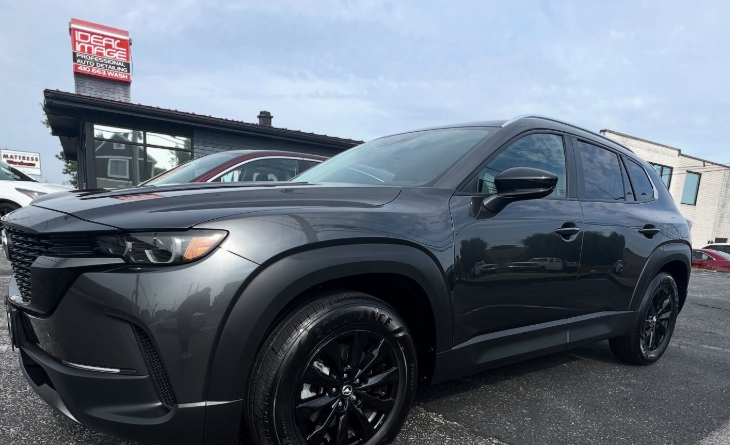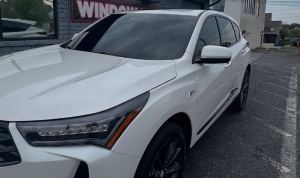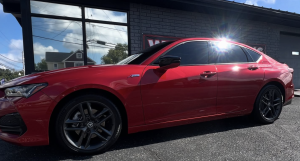Winter has a way of turning car care into an exercise in frostbite avoidance. You take a deep breath, grab a bucket and hose, and five minutes later you’ve got ice on your gloves and a new coat of road-salt frosting on the rocker panels. So when exactly is it too cold to wash your car — and does that mean you have to wait until spring to get a proper detail? Short answer: don’t wash your car outside when temperatures are at or below freezing, but professional detailing can (and should) be done year-round when done in a climate-controlled facility.
Here’s a practical, no-nonsense guide to help you decide when to DIY and when to book a pro — plus tips to protect your finish through whatever Mother Nature throws at you.
Why cold weather changes everything
Cold temperatures affect basic car-care chemistry and physics in ways that make washing and detailing outdoors risky:
- Freezing water: If rinse water freezes on the car, it can lock dirt and salt into crevices, cause streaking, or form ice that forces doors, trunks, and fuel caps to stick. Frozen water in locks or seals is a classic winter annoyance.
- Shampoo performance drops: Detergents and cleaners don’t work as effectively when they’re cold; they rinse poorly and can leave residue.
- Paint and trim become brittle: Materials contract and become less forgiving; aggressive scrubbing or polishing on very cold panels raises the risk of microcracking or brittle plastic snapping.
- Coating/film curing needs: Many paint-protection products (ceramic coatings, adhesives for PPF) have minimum temperature and humidity windows to cure properly. Poor curing leads to reduced performance and shortened life.
- Safety and comfort: Cold conditions make it harder to do a thorough job without cutting corners (and you don’t want corners cut on your car’s finish).
Temperature rules of thumb
Use these conservative thresholds when deciding whether to wash or detail outdoors:
- Below 32°F / 0°C — Do not wash or use water-based methods outdoors. Water freezes at this point; even a quick rinse risks ice formation in seams, locks, and wipers.
- 32°F–40°F (0–5°C) — Very risky for detailed work. Quick rinses can be done in a pinch (and only if you can dry thoroughly and avoid trapped water), but skip polishing, clay bar, coatings, or any process requiring adhesion or curing.
- 40°F–50°F (5–10°C) — Possible for basic washing if conditions are calm and you can dry thoroughly; not ideal for coatings.
- 50°F (10°C) and above — Much safer for washing and detailing; many professionals prefer 60°F+ for coating/PPF work, but shops with heated, controlled bays can work at lower temps safely.
These numbers are guidelines — exact limits depend on the specific products and installers. Always follow the product and installer recommendations for coatings and film.
Why professional detailing can be done all year (and why that matters)
Professional detailers don’t rely on the weather. Here’s how they make year-round protection possible:
- Climate-controlled bays: Professional shops have heated, dust-controlled work areas where coatings and PPF adhesives cure properly regardless of outdoor temps.
- Correct tools and equipment: High-quality extractors, steam cleaners, and forced-air drying eliminate moisture quickly and thoroughly — critical in cold months.
- Product knowledge and choice: Pros select formulations rated for cooler curing when needed, or they schedule work for the warmest part of the day and use heaters and dehumidifiers to create ideal curing conditions.
- Thorough prep and expertise: Good detailing is preparation-heavy. Pros thoroughly decontaminate, correct paint, and pre-treat surfaces so coatings and films bond correctly — something that’s hard to guarantee with a driveway wash.
- Warranty and accountability: Professional installations come with manufacturer or installer warranties that often require certified application and proper curing conditions — protections you don’t get with a backyard DIY.
In short: if you want coatings, PPF, or paint correction before winter, get them done by a pro inside a proper facility. That way your protection actually protects.
What you can (and should) do yourself during cold months
If you’re avoiding a full detail but still want to minimize winter damage:
- Spot-rinse and dry: If you must remove salt and grime, use lukewarm water for quick rinses and dry seams and door jambs with a proper towel or forced-air dryer (if available).
- Wash frequency: Rinse the undercarriage regularly during salt season. That helps prevent corrosion more than obsessing over the hood.
- Use the right products: pH-neutral car shampoo, microfiber wash mitts, and the two-bucket method reduce abrasion.
- Avoid automatic brush washes in cold weather: These can abrade film or lift edges, and frozen brush residues are worse than clean water.
- Protect seals and locks: Apply a silicone lubricant to door seals and a graphite or de-icer product to locks as needed.
- Keep interior tidy: That reduces moisture traps that can cause mildew during damp, cold weather.
Winter-friendly professional services
If you decide to book a pro during the colder months, here are services that are commonly performed year-round (when done in-shop):
- Interior deep cleaning: Steam extraction, odor removal, and upholstery treatment — fully safe in any season.
- Headlight restoration and trim restoration: Done indoors; improves visibility and appearance immediately.
- Undercarriage and wheel well cleaning: Great for salt season, prevents corrosion.
- Partial or full PPF installation and ceramic coatings: When performed in a heated bay by a certified installer.
- Paint correction and polishing: Best indoors to prevent dust and ensure proper pad temperatures.
- Engine degreasing and dressing: Performed in-shop with proper drainage and drying.
Final checklist — Is it too cold for you to wash your car today?
- Is outdoor temp at or below 32°F / 0°C? If yes, don’t wash outside.
- Can you dry the car immediately and fully? If no, don’t rinse.
- Are you planning coatings, PPF, or polishing? If yes, schedule with a professional indoor shop.
- Is your biggest concern salt and underbody corrosion? If so, prioritize an undercarriage rinse (done at a proper facility) and consider a PPF front-end or ceramic coating applied indoors.
Wrap-up: Protect your finish — not your frostbite
Cold weather complicates car care, but it shouldn’t leave your paint defenseless. The safe rule: avoid water-based detailing outdoors at freezing temperatures, and trust professionals with year-round services because they control the environment, use the right products, and back their work with warranties.
If you’d like, we can recommend a winter-ready protection plan — front-end PPF plus a ceramic top coat or a targeted winter detail package that focuses on undercarriage rinsing, interior sanitizing, and seal protection. Bring your car to our heated detailing bay and leave the weather to the meteorologists.
Ideal Image Auto Salon
7901 Belair Rd, Nottingham, MD 21236
Phone: (410) 663-8468





